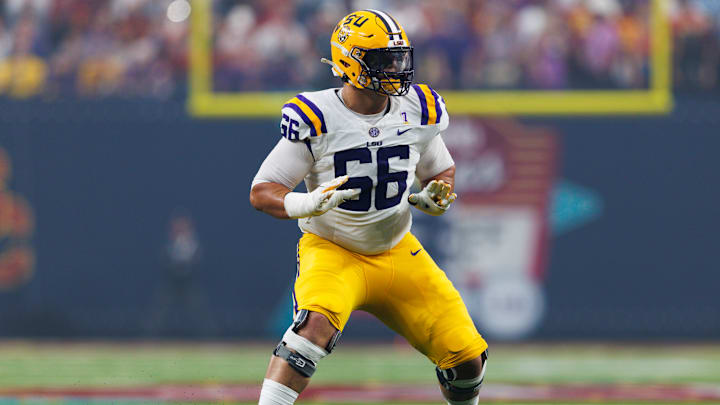When it comes to evaluating offensive tackles in the NFL, few traits spark more debate than arm length. However, does it really matter? With draft rumors that Will Campbell is a top potential draft target of the Chicago Bears, I felt compelled to see if he was worthy of a top 10 pick. I dug into the data of every starting and backup offensive tackle from every NFL team to find out.
Why scouts obsess over arm length
NFL teams have long believed that arm length is critical for offensive tackles -- especially left tackles who protect the quarterback's blind side. This is especially true when facing elite edge rushers like Khalil Mack, Myles Garrett, and Micah Parsons. Longer arms help tackles create separation from defenders, recover quicker when beaten, control leverage at the point of attack, and create a larger radius for the pocket. The unwritten rule was always that NFL teams prefer tackles with arms over 34", with some considering 33" and below a major red flag. However, what do the numbers truly say?
Looking at the most recent depth charts of every NFL team, there are 64 starting offensive tackles and 62 immediate backups (the Ravens don't list backup OTs at this time).
The data that stands out regarding starting OTs
- Average arm length for starting left tackles is 34.6"
- Average arm length for starting right tackles is slightly lower at 34.3"
- Onlly 4 starting tackles in the NFL have arms shorter than 33"
- Over 65% of starters have arms measuring 34" or longer
The data that stands out regarding backup OTs
- Over 66% of backups have arms measuring 34" or longer
- 15 backup tackles have arms shorter than 33.5"
- Only 8 backup tackles in the NFL have arms shorter than 33"
This data supports the idea that arm length is highly touted for both starting and backup offensive tackles, however, NFL teams may be a little more flexible with backups.
Obviously, there are a few exceptions. For example, both the starting offensive tackles for the Indianapolis Colts have tackles with sub-33" arms. Braden Smith is considered one of the better RT in the league, too. The Bucs and Falcons both have starting RTs with sub-33" arms as well. However, these all seem to be outliers and not the blueprint.
What does this mean for Will Campbell and the Chicago Bears?
The Chicago Bears are in a position to upgrade their offensive line. Unfortunately, there isn't a top-of-the-line LT prospect in this draft class like we have seen in years past. Will Campbell is the best prospect at the position on most mock draft boards, but he measured in with an arm length of 32.6" at the Combine and magically measured 33" at his Pro Day. Even at 33", his arm length is less than ideal, especially when you factor in his 77" wingspan. Can Campbell be an outlier too? He possesses the elite footwork and technical skills needed to overcome shorter arms, but will it be enough?
One big difference when it comes to Will Campbell and the other outliers, assuming he truly measures less than 33" as originally reported at the NFL Combine, is his projected draft position. Let's look at some NFL Draft data reflective of arm length.
- Tackles drafted in the 1st or 2nd rounds overwhelmingly have arms longer than 34"
- Sub 33" arm lengths were found almost exclusively among Day 3 picks or undrafted free agents (UDFA)
- Only one tackle with sub-33" arms was drafted in the first round but was drafted at 31st overall
- The four starting OTs with sub-33" arms were all drafted within the top 77 picks
This suggests that NFL teams heavily weigh arm length when deciding who is worthy of a top 75 pick, especially at left tackle. It's not just a preference - it's a historical threshold. However, one thing to note is that Detroit, Ben Johnson's former team, had two starting tackles with sub-34" long arms. Maybe arm length isn't as big of a concern for Johnson as it others.
Why does this matter? If the Chicago Bears are considering Will Campbell at 10, he'd be a major outlier if he were to truly succeed at left tackle and not be kicked inside to play guard. Being moved inside is what usually happens with tackles with shorter arms - see Peter Skoronski for a recent example. Is a guard truly worthy of a top 10 pick? Maybe.
My fear is that it isn't as easy a transition as many think, and Campbell plays a little too upright to be an elite guard - something he doesn't have to worry about as much while playing left tackle. As I mentioned, though, he has great footwork, is a tactician, and has a strong anchor. He proved himself worthy against elite SEC talent, and the Bears are in an interesting position to take advantage of Campbell's situation. Braxton Jones isn't fully healthy, and Joe Thuney is only here on a one-year deal. Campbell could start at left tackle for now and either take over or kick into RG in 2026.
